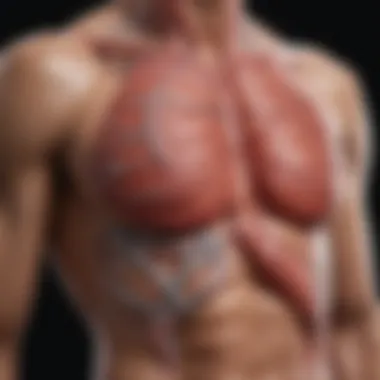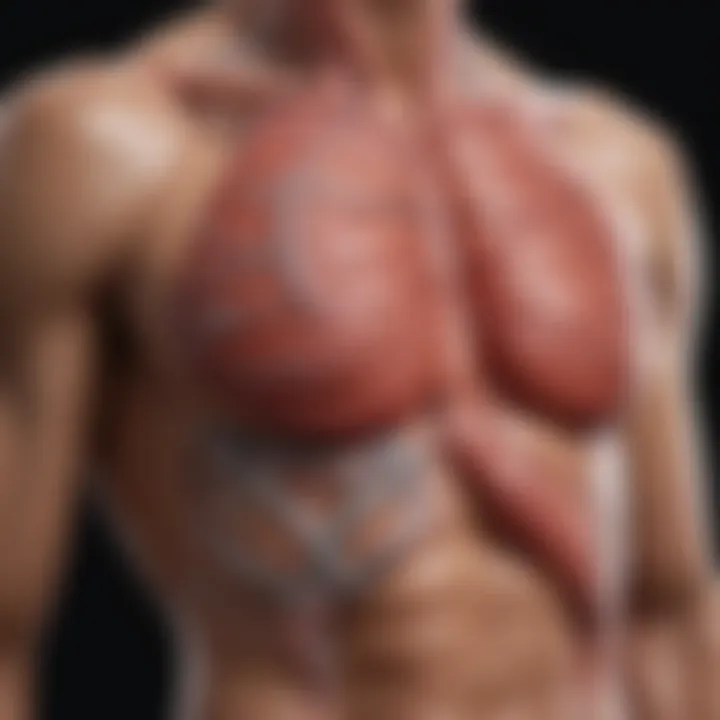Deep Breathing's Impact on High Blood Pressure


Intro
The relationship between high blood pressure and deep breathing is intriguing. It combines both physiological responses and psychological activities. This article will explore how deep breathing techniques influence blood pressure, discussing various mechanisms that contribute to cardiovascular health. There is growing interest in natural interventions to manage hypertension, and deep breathing presents an accessible option for many.
Research Overview
Summary of Key Findings
Research has indicated that deep breathing can lead to a reduction in blood pressure. Several studies demonstrate that mindful breathing exercises effectively lower systolic and diastolic readings. Furthermore, incorporating deep breathing into daily routines may improve overall cardiovascular health. The findings suggest a multifaceted interaction where both the mind and body are engaged, leading to a reduction in stress levels and an improvement in physiological responses.
Background and Context
Hypertension is a widespread health issue that affects many individuals. As traditional pharmaceutical interventions may have side effects or may not always be effective, alternative methods become significant. Deep breathing exercises, derived from practices like yoga and meditation, are often highlighted for their benefits. They utilize controlled breathing to instigate a relaxation response in the body, opposing the fight-or-flight reaction that leads to elevated blood pressure. Understanding this interaction requires a review of existing literature, focusing on how breathing techniques can act as an adjunct to conventional treatment approaches.
Methodology
Experimental Design
Studies investigating the effects of deep breathing on blood pressure typically involve controlled experiments. Participants are assigned to various groups, including those utilizing deep breathing techniques and control groups engaging in regular activities. Measurements of blood pressure are taken before, during, and after the sessions, allowing for a clear analysis of the impacts.
Data Collection Techniques
Data is collected through various means such as sphygmomanometers for blood pressure readings, questionnaires assessing perceived stress levels, and physiological measurements like heart rate variability. Self-reported stress levels also play a role, providing insight into the psychological impact of deep breathing. This combination of subjective and objective data enhances the validity of the findings, making it comprehensible how deep breathing may serve as an effective tool in managing hypertension.
"Deep breathing techniques represent a compelling non-pharmaceutical intervention for individuals striving to achieve better control over their blood pressure."
Understanding High Blood Pressure
High blood pressure, often referred to as hypertension, is a significant health concern that affects millions globally. Understanding this condition is essential for several reasons. First, hypertension is often asymptomatic, leaving individuals unaware of their elevated blood pressure levels. If left untreated, it can lead to serious health complications, including heart disease, stroke, and kidney failure.
Moreover, understanding high blood pressure provides insights into how lifestyle choices, such as diet and exercise, can significantly affect one’s cardiovascular health. This knowledge empowers individuals to take proactive measures in their health management, including integrating effective techniques like deep breathing into their daily routines.
Definition and Normal Range
High blood pressure occurs when the force of the blood against the artery walls is too high. Blood pressure readings consist of two numbers: systolic and diastolic. The systolic number represents the pressure in the arteries when the heart beats, while the diastolic number measures the pressure when the heart rests between beats.
A normal blood pressure reading is typically around 120/80 mmHg. Readings above this range indicate varying degrees of hypertension. For instance, a reading between 130-139 systolic or 80-89 diastolic is classified as stage 1 hypertension.
Causes of Hypertension
Several factors contribute to the development of hypertension. Common causes include:
- Genetic predisposition: A family history of hypertension can increase one’s risk.
- Obesity: Excess body weight can strain the heart, leading to higher blood pressure.
- Lack of physical activity: An inactive lifestyle often correlates with increased levels of hypertension.
- Unhealthy diet: High salt intake, excessive alcohol consumption, and low potassium levels can elevate blood pressure.
- Stress: Chronic stress may contribute to short-term spikes in blood pressure, potentially leading to longer-term issues.
Identifying these risk factors is vital for prevention and intervention.
Prevalence and Impact
The prevalence of high blood pressure is alarming. According to the World Health Organization, estimated 1.13 billion people worldwide have hypertension, and less than 1 in 5 have it under control. This inability to manage blood pressure effectively results in substantial health care costs and impacts daily living quality.
Hypertension particularly affects specific demographics. For example, older adults are more likely to develop high blood pressure. Additionally, certain racial and ethnic groups, such as African Americans, have higher susceptibility. The impacts of hypertension are profound, affecting not only physical well-being but also mental health, leading to increased anxiety and stress for those living with the condition.
Overall, comprehending high blood pressure is critical for promoting awareness, developing effective strategies for management, and empowering people to take control of their health.
Physiological Mechanisms of Blood Pressure Regulation


Blood pressure regulation is central to understanding cardiovascular health. It involves several complex systems working together to maintain homeostasis. The significance of this topic is vast; on one hand, it helps in recognizing how external interventions, like deep breathing, might come into play in managing hypertension. On the other hand, it also sheds light on natural bodily functions that can be influenced by psychological and physiological changes. Through analyzing these mechanisms, researchers and health professionals can develop targeted strategies for managing high blood pressure effectively.
Role of the Autonomic Nervous System
The autonomic nervous system (ANS) plays a crucial role in regulating blood pressure. It is divided into two parts: the sympathetic and parasympathetic nervous systems. The sympathetic nervous system is often associated with the body’s stress response, increasing heart rate and constricting blood vessels, which raises blood pressure. Conversely, the parasympathetic system promotes relaxation, slowing the heart rate and allowing vessels to dilate, thereby reducing blood pressure.
Deep breathing exercises can influence this balance. When individuals engage in deep, regulated breathing, the parasympathetic system is activated. This activation can lead to a decrease in heart rate and promote vasodilation. Such physiological changes directly contribute to lowering blood pressure. Studies emphasize that controlled breathing enhances the body’s overall ability to handle stress and maintain emotional equilibrium, further substantiating the connection between deep breathing practices and blood pressure regulation.
Influence of Hormonal Regulation
Hormonal regulation is another vital component in blood pressure control. Several hormones are involved, including adrenaline, norepinephrine, and cortisol, which can either raise or lower blood pressure depending on their levels and interaction with blood vessel receptors. When stress is induced, the body typically releases hormones that lead to increased heart rate and vascular resistance.
Implementing deep breathing techniques can modulate hormonal responses. For instance, these techniques trigger the release of oxytocin and lower cortisol levels. This interplay can help to mitigate the elevated blood pressure associated with stress. Understanding this regulatory mechanism highlights the potential effectiveness of deep breathing as a practical, non-pharmaceutical approach to maintaining hypertension within normal limits. Furthermore, individuals who regularly practice deep breathing exercises may experience a sort of hormonal training effect, leading to long-term improvements in their blood pressure profile.
"Hormonal balance and the autonomic nervous system act in concert. Together, they create a dynamic framework for blood pressure regulation".
In summary, both the autonomic nervous system and hormonal regulation are integral to the physiological understanding of blood pressure management. Harnessing these mechanisms through deep breathing techniques offers a promising avenue for non-drug interventions targeting high blood pressure.
Prelude to Deep Breathing Techniques
Deep breathing techniques hold significant importance in the discourse surrounding high blood pressure management. They offer a non-invasive method to influence cardiovascular health positively. Understanding these techniques is crucial, especially as hypertension continues to affect a significant portion of the global population. Deep breathing can help reduce stress and anxiety, two factors often linked to elevated blood pressure. This section examines various types of breathing exercises and their historical context, providing insight into their profound impact on well-being.
Types of Breathing Exercises
There are various types of breathing exercises that individuals can engage in to promote relaxation and potentially lower blood pressure. Some of these techniques include:
- Diaphragmatic Breathing: This technique involves fully engaging the diaphragm, allowing for deeper breaths. It helps to increase oxygen flow and promote relaxation.
- Box Breathing: A structured method where you inhale for four seconds, hold for four seconds, exhale for four seconds, and hold again for four seconds. It is effective in calming the mind and body.
- 4-7-8 Breathing: This involves inhaling for four seconds, holding the breath for seven seconds, and then exhaling for eight seconds. It is believed to help in managing anxiety effectively.
- Alternate Nostril Breathing: This yoga practice involves breathing through one nostril at a time, promoting balance and calmness.
Each of these techniques can be tailored to individual preference and specific health needs, allowing for a personalized approach to blood pressure management.
Historical and Cultural Context
The practice of deep breathing has roots in various historical and cultural contexts. In many ancient traditions, breathing techniques were integral to spiritual practices and holistic health. For instance, yoga, which originated in India, emphasizes breath control as a means to enhance physical and mental well-being. Similarly, in Chinese medicine, breathing practices are linked to the flow of "qi," or life energy, throughout the body.
In modern times, these cultural practices have been adapted into different therapeutic contexts. The Western medical community increasingly recognizes the importance of mindfulness and breathing techniques in managing stress and reducing high blood pressure. Various studies confirm that incorporating deep breathing into daily routines can lead to sustainable improvements in cardiovascular health.
"Breathing is the first act of life, and the last. Our very life depends on it If you learn to breathe correctly and deeply, you will find that your body and mind can cope with the stress of daily life."
As society continues to evolve, the integration of these ancient practices into modern health strategies underscores their enduring relevance and effectiveness.
Mechanisms of Deep Breathing Effects
The exploration of deep breathing mechanisms is essential to understand how these techniques can actively influence high blood pressure. Breathing, a fundamental yet often overlooked aspect of physiological regulation, entails a diverse array of responses that go beyond mere oxygen intake. It embodies an intricate system capable of modulating both physiological and psychological states, making it an invaluable tool in hypertension management.
Physiological Responses to Deep Breathing
When engaging in deep breathing, the body undergoes notable physiological changes that may help to reduce high blood pressure.
- Activation of the Parasympathetic Nervous System: Deep breathing stimulates the parasympathetic nervous system, which counteracts the stress-induced responses often associated with hypertension. By promoting relaxation, deep breathing can help achieve a balance in the autonomic nervous system, fostering a reduction in heart rate and blood pressure.
- Reduction in Stress Hormones: Techniques such as diaphragm breathing can lower levels of stress hormones like cortisol. High cortisol levels are linked to increased blood pressure; thus, minimizing this hormone can have a beneficial effect on cardiovascular health.
- Vascular Relaxation: Deep inhalation leads to a better oxygen exchange and enhances the blood's oxygen-carrying capacity. This can result in improved circulation and vascular relaxation, subsequently aiding in blood pressure regulation.
- Enhanced Respiratory Efficiency: Deep breathing improves lung capacity and oxygen efficiency, which may enhance overall vital organ function. This increased efficiency contributes to a healthier cardiovascular system, thus potentially lowering high blood pressure.
"Breathing deeply not only minimizes daily stress but also plays a pivotal role in regulating blood pressure through physiological adaptations."
Psychological Impact of Breathing Techniques
The psychological dimensions of deep breathing offer further insights into its effectiveness in controlling high blood pressure.
- Stress and Anxiety Reduction: Engaging in deep breathing exercises can significantly alleviate feelings of anxiety and stress. Mental stress is a known contributor to elevated blood pressure, and by calming the mind, individuals may experience a beneficial influence on their cardiovascular health.
- Improved Mindfulness: Deep breathing techniques can foster an enhanced sense of mindfulness which increases self-awareness. This awareness can lead to healthier lifestyle choices, including better diet and exercise, which in turn supports blood pressure management.
- Enhanced Mood Regulation: Regular practice of breathing exercises is associated with improved mood and emotional stability. A positive mental state can help mitigate factors contributing to high blood pressure, thus reinforcing the health benefits of deep breathing.


The mechanisms of deep breathing show that it’s not merely about inhaling and exhaling; it is a comprehensive approach with diverse physiological and psychological implications which are vital in high blood pressure management.
Research Evidence on Deep Breathing and Blood Pressure
The exploration of the influence of deep breathing techniques on high blood pressure is significant in understanding both the physiological and psychological dimensions of cardiovascular health. Research evidence in this domain serves as a cornerstone for validating claims regarding the efficacy of deep breathing as a non-pharmaceutical intervention. The integration of studies and clinical findings underscores the relevance of these techniques in managing hypertension effectively. With an increase in blood pressure readings globally, evaluating alternative practices, such as deep breathing, becomes increasingly vital.
Clinical Trials and Findings
Numerous clinical trials have investigated how deep breathing can lead to reductions in blood pressure. These studies often employ diverse methodologies, examining variables such as duration, frequency, and specific breathing patterns. A systematic review of these trials reveals that many participants experienced statistically significant reductions in their systolic and diastolic blood pressure levels.
For instance, a randomized controlled trial published in a leading cardiovascular journal found that participants practicing deep breathing exercises twice daily for eight weeks exhibited a marked decrease in both systolic and diastolic readings compared to a control group. These findings emphasize that consistent practice of deep breathing not only promotes relaxation but also serves as an effective tool in lowering blood pressure.
Additionally, many of these trials highlight that the physiological mechanisms at play include a decrease in heart rate and vasodilation, which contributes to a more balanced blood flow. The cumulative evidence from these clinical evaluations adds credibility to the argument for incorporating deep breathing exercises into routine health regimens for individuals with high blood pressure issues.
"Engaging in breathing techniques can significantly alter cardiovascular responses, demonstrating the body's ability to adapt to stress through simple yet powerful interventions."
Comparative Studies with Other Interventions
Comparative studies further elucidate the unique position of deep breathing within the broader context of hypertension management. Many of these studies place deep breathing alongside other interventions, such as aerobic exercise, dietary modifications, and even pharmacological treatments. It is critical to note the synergy that can arise from integrating breathing exercises with these traditional approaches.
Research indicates that while conventional treatments often yield quick results, deep breathing techniques may offer long-term benefits without the side effects associated with medication. For example, a comparative meta-analysis revealed that subjects who incorporated deep breathing exercises alongside lifestyle changes saw more sustainable improvements in their blood pressure when contrasted with those who relied solely on exercise or medication.
Thus, these studies reinforce the notion that deep breathing can complement existing treatment plans, enhancing the overall efficacy of blood pressure management strategies. This integration not only emphasizes the need for a holistic approach to health but also suggests that further exploration into this intersection could yield even more refined methods for managing hypertension.
Implementing Deep Breathing in Daily Life
Implementing deep breathing in daily life is essential for managing high blood pressure and improving overall cardiovascular health. The integration of such practices can serve not only as a method for immediate stress relief but also as a long-term approach to enhance physical well-being. With increasing awareness of non-pharmaceutical interventions, the significance of deep breathing is gaining attention. By incorporating practical exercises into daily routines, individuals can better equip themselves to face the challenges posed by hypertension.
Practical Breathing Exercises
Practical breathing exercises are designed to be easy and accessible. They can be done anywhere and at any time, making them a convenient option for many. Here are a few effective techniques:
- Diaphragmatic Breathing: Also known as abdominal breathing, this technique focuses on engaging the diaphragm, allowing for deeper inhalations. This method improves oxygen exchange and calms the nervous system.
- Box Breathing: This technique involves inhaling for four seconds, holding for four seconds, exhaling for four seconds, and holding again for four seconds. It can quickly induce relaxation and clarity.
- 4-7-8 Breathing: Inhale through the nose for four seconds, hold the breath for seven seconds, and exhale for eight seconds. This method can help reduce anxiety and lower heart rate.
Practicing these exercises consistently can enhance lung capacity and lead to improvements in stress levels.
Creating a Routine for Blood Pressure Management
Establishing a routine for deep breathing is crucial for effective blood pressure management. This can be achieved by setting aside dedicated time each day, such as in the morning or before bedtime, to practice specific breathing exercises. The following steps can guide this process:
- Choose a Time: Identify when you are most likely to practice deep breathing, whether in the morning to start your day calmly or at night to unwind.
- Create a Space: Find a quiet and comfortable location where you can focus without interruptions. This could be a corner of your bedroom or even during a break at work.
- Set a Goal: Start with a few minutes of deep breathing, aiming to gradually increase duration as you become more comfortable with the practice.
- Track Your Progress: Keeping a journal of your practice can help in recognizing benefits over time. Note any changes in blood pressure or stress levels, which may serve as motivation.
By establishing a routine and being mindful of the need for self-care, individuals can effectively implement deep breathing techniques into their lives. Such integration fosters not only better physical health but can also improve emotional resilience.
Risks and Considerations
Understanding the risks and considerations associated with deep breathing techniques is vital. This practice, while generally viewed as beneficial, can have negative outcomes for some individuals. A deeper awareness of these aspects can greatly enhance the overall efficacy of breathing methods in managing high blood pressure.
Possible Adverse Effects of Overdoing Techniques
Excessive practice of deep breathing can lead to unwanted complications. The body can experience hyperventilation, which may result in dizziness, tingling in the extremities, or even fainting. When individuals breathe too deeply and too rapidly, carbon dioxide levels decrease drastically. This may induce respiratory alkalosis—a disturbance in the body’s acid-base balance.
Furthermore, overindulgence in intense breathing exercises might overstimulate the autonomic nervous system. This reactivity could elevate heart rates in sensitive individuals, rather than achieving the desired calming effects. Such responses emphasize the importance of moderation and awareness.
Key Points to Consider:


- Hyperventilation risks: dizziness, tingling, fainting.
- Respiratory alkalosis from decreased carbon dioxide levels.
- Overstimulation of the autonomic nervous system.
"Moderation in all things, even breathing, is a valuable principle for managing health."
Individual Differences and Tailored Approaches
Each person's physiological responses to deep breathing vary. Factors such as age, existing health conditions, and even psychological states play significant roles. Consequently, a one-size-fits-all approach is ineffective and may even be detrimental. For example, older adults may find it harder to engage in strenuous breathing exercises due to reduced lung capacity.
Additionally, those with pre-existing respiratory issues, such as asthma, should approach deep breathing techniques with caution. Tailoring interventions to individual needs allows for improved outcomes. Practitioners should evaluate a person’s health backdrop, preferences, and comfort levels when designing a breathing routine.
Considerations for Tailored Approaches:
- Assessing individual health backgrounds.
- Considering age and lung capacity.
- Monitoring psychological states and stress levels.
The Role of Healthcare Practitioners
Healthcare practitioners play a critical role in managing high blood pressure through various means, including the incorporation of deep breathing techniques. These professionals not only diagnose and treat hypertension but also educate patients on lifestyle changes that can complement medication and improve overall well-being. A holistic approach to treatment is increasingly recognized as essential, particularly considering the chronic nature of hypertension and its implications on patients’ lives.
Deep breathing exercises offer an accessible and effective strategy for patients who may be hesitant to rely solely on pharmaceuticals. Despite the existence of numerous conventional treatment options, the nuanced influence of breathing techniques has gained traction in many clinical settings. This is particularly pertinent in light of the growing body of research supporting these methods. By integrating these exercises into treatment plans, healthcare practitioners can empower patients to take active roles in managing their blood pressure.
One must consider that the relationship between the practitioner and patient is built on trust and communication. By presenting deep breathing as a viable option, practitioners can foster a more collaborative atmosphere. This approach can reduce anxiety, enhance patient adherence to treatment regimens, and elevate the overall quality of care provided.
Integrating Breathing Techniques into Treatment Plans
When devising treatment plans, healthcare practitioners must evaluate a multitude of factors unique to each patient. Integrating breathing techniques requires careful consideration of individual health profiles, preferences, and the presence of any comorbid conditions. Practitioners should start by conducting a thorough assessment to identify whether a patient could benefit from these techniques. Prospective advantages include reduced blood pressure levels, stress reduction, and enhanced emotional well-being.
It is essential for practitioners to provide clear instructions on various breathing techniques, including diaphragmatic breathing and paced breathing. They should encourage practice in a comfortable environment, gradually increasing the duration and complexity as the patient becomes more proficient. Additionally, tracking progress can further motivate patients. Establishing a system for monitoring blood pressure changes in conjunction with the implementation of these techniques can illustrate tangible benefits over time.
Educating patients on the science behind deep breathing can help demystify its effects. When patients understand that controlled breathing may trigger parasympathetic responses that counteract stress-induced hypertension, they may be more inclined to adopt these practices.
Educating Patients on Non-Pharmaceutical Options
Education is a fundamental aspect of the healthcare experience. Patients overwhelmed by the vast array of treatment options often appreciate guidance on non-pharmaceutical alternatives. By presenting these alternatives, practitioners can help patients navigate their choices without the pressure of medication dependency.
Healthcare practitioners should provide patients with resources that include information on the physiological benefits of deep breathing, alongside practical applications and techniques. Emphasizing the accessibility of these exercises reinforces the idea that effective management does not always require medication.
Engaging patients in conversations about their preferences and concerns may lead to a deeper understanding of their personal health journeys. Practitioners can facilitate workshops or group sessions focusing on deep breathing, allowing patients to learn together, share experiences, and support one another in their travels toward better health.
Future Research Directions
The exploration of deep breathing techniques as a potential intervention for high blood pressure reveals numerous pathways for further research. This evolving area underscores the necessity of ongoing inquiry to enrich our understanding of the physiological and psychological implications that deep breathing can have on hypertension management. There are several specific elements that warrant detailed investigation, which may greatly benefit both clinical practices and individual wellness strategies.
Areas Needing Further Investigation
One significant area for development is the quantification of specific deep breathing techniques and their distinct impacts on blood pressure levels. For instance, emerging evidence suggests that variation in breathing patterns, such as duration and frequency, could result in different physiological responses. Further studies should aim to systematically assess which techniques yield the most substantial benefits in lowering blood pressure.
More robust clinical trials are essential to establish cause-effect relationships, as many existing studies are limited in sample size or methodology. Investigating the role of biological markers in conjunction with deep breathing practice could provide deeper insights into how relaxation impacts cardiovascular health.
Additionally, studies that examine the long-term effects of regular deep breathing and its sustainability as a practice in diverse populations remain scarce. Understanding individual differences—such as age, gender, lifestyle factors, and baseline stress levels—could help tailor interventions more effectively.
Potential for Policy Changes
The integration of deep breathing techniques into public health policies presents an exciting opportunity. As studies persistently highlight the effectiveness of non-pharmaceutical interventions, there is potential to reshape healthcare approaches. Policymakers may consider incorporating breathing programs into standard hypertension management guidelines.
Such policy advancements could lead to funding for community workshops and educational tools that promote deep breathing practices in schools and workplaces. This can encourage wider adoption and provide essential resources for those at risk of hypertension. The promotion of deep breathing as a daily health habit aligns well with current shifts towards preventive healthcare measures, emphasizing lifestyle modifications rather than solely relying on medication.
Concluding Thoughts
In this article, we explored the profound relationship between deep breathing techniques and high blood pressure. Recognizing that hypertension is a significant public health concern, we articulated how controlled breathing can potentially serve as a non-pharmaceutical intervention to manage this condition. As emphasized throughout our analysis, the physiological impacts of deep breathing are manifold. It helps lower heart rate, reduces stress hormone levels, and promotes vascular relaxation. These mechanisms collectively contribute to a decrease in blood pressure.
Furthermore, the psychological benefits cannot be overlooked. Engaging in structured breathing exercises has been shown to enhance mental well-being. This aspect is especially crucial, given that stress is a common trigger for hypertension. Deep breathing not only calms the mind but can also create a more favorable environment for cardiovascular health. The holistic approach that combines both physiological and psychological dimensions provides a more comprehensive understanding of managing high blood pressure.
"In the realm of hypertension, simple practices like deep breathing may hold significant untapped potential."
It is crucial to consider individual differences when recommending deep breathing techniques. What works for one person may not be effective for another. Hence, personalization in practice should be a guiding principle. By factoring in these nuances, healthcare practitioners can better integrate deep breathing into treatment plans, thus resulting in a more tailored approach to hypertension management.
As we reflect on the findings, it becomes clear that further research is warranted. The potential for advancing our understanding of the effects of deep breathing techniques on high blood pressure could lead to innovations in treatment strategies that prioritize both effectiveness and patient comfort. This area merits deeper investigation, which can further illuminate the intricate mechanisms at play.
Thus, the intersection of deep breathing and blood pressure management is not just a topic of academic interest but a vital area with the potential for real-world applications. By fostering awareness and encouraging continued exploration, we can pave the way for more comprehensive health strategies that embrace the simplicity and power of mindful breathing.







